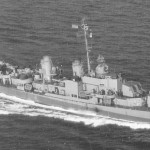
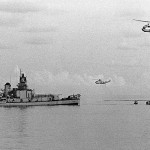 On the night of June 3, 1969 the U.S.S. Frank E. Evans (DD-754) was involved in a collision with the Royal Australian Navy aircraft carrier Melbourne in the South China Sea – an accident eerily similar to the U.S.S Hobson/U.S.S Wasp collision 17 years before. Flight operations were in progress on the Melbourne and the Evans was maneuvering into its correct position reference to the carrier. As in the Hobson incident, an error in judgement was made on the bridge of the Evans. The Melbourne struck Evans amidships, cutting her in half. The bow section of the Evans sank almost immediately, taking 74 of her crew to their deaths. One body was recovered, 73 were lost at sea. The photos at the top left show the Evans before and after the accident.
On the night of June 3, 1969 the U.S.S. Frank E. Evans (DD-754) was involved in a collision with the Royal Australian Navy aircraft carrier Melbourne in the South China Sea – an accident eerily similar to the U.S.S Hobson/U.S.S Wasp collision 17 years before. Flight operations were in progress on the Melbourne and the Evans was maneuvering into its correct position reference to the carrier. As in the Hobson incident, an error in judgement was made on the bridge of the Evans. The Melbourne struck Evans amidships, cutting her in half. The bow section of the Evans sank almost immediately, taking 74 of her crew to their deaths. One body was recovered, 73 were lost at sea. The photos at the top left show the Evans before and after the accident.
The whole story of the Evans can be found at the superb website of the U.S.S. Frank E. Evans (DD-754) Association: http://ussfrankeevansassociationdd754.org
Spend some serious time on this website. It is the finest website devoted to a single ship that I have ever seen, lovingly maintained by former members of the Evans crew during her long and proud history. She served in three wars with distinction. Her entire history is contained within the website. There are several memorials to the Evans’ lost souls in the United States, including one in Arlington National Cemetery. There is also a beautiful memorial in Australia.
There is one memorial to the Evans in the United States that personalizes the tragedy beyond all the others, however. It is not large in size. I doubt if it was designed by a professional artist or cost as much as the other Evans memorials. It is not on the beaten track either – it’s located on a plaza in a very small town called Niobrara, Nebraska.
Among the dead and forever lost at sea on that awful night in 1969 were three brother from Niobrara – Gary, Kelly and Gregory Sage. It was the worst single family toll in the U.S. Navy since the five Sullivan brothers were killed in the sinking of the U.S.S Juneau in 1942 near Guadalcanal. Even today, after four decades have passed, it’s difficult to comprehend the sense of loss that must have been felt by the brothers’ parents, the widow of one of the brothers, the immediate family, and the entire small Nebraska town that they called home.
The memorial is in two parts. One is a plaque that describes the accident. In front of and below the plaque, resting on the ground, is a simple granite block. On the front of that block are five words, one date, and a single oval photograph. The power of that photograph is how it humanizes the loss of all those souls that night. It’s hard to imagine a more powerful image on any memorial anywhere.
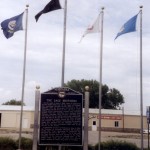
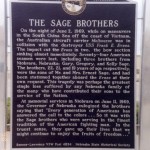
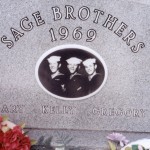 For more information on the Sage brothers and the 1999 dedication of this memorial, please visit the U.S.S. Frank E. Evans Association website and click their ‘News’ section. Under the same section you will find photographs of all the sailors who died that night and forever rest in the deep waters of the tropical Pacific.
For more information on the Sage brothers and the 1999 dedication of this memorial, please visit the U.S.S. Frank E. Evans Association website and click their ‘News’ section. Under the same section you will find photographs of all the sailors who died that night and forever rest in the deep waters of the tropical Pacific.
Frank Jablonski said:
Thank you for your kind words about our website.
Frank Jablonski, Historian
USS FRANK E. EVANS (DD 754)
Lest We Forget!
John Coffey said:
Sir, I am the Director of Communication for the USS Frank E Evans Association and I so much appreciate your kind works about our former home away from home and the men who served in her. I served aboard her from 1962 to 1964 as a radarman. And I am so fortunate to have met and shared ‘war stories’ with so many fine men.
Thank you, again, for your visit and your post. Hopefully, in a few days I will have a blog up for others to visit and comment on, too.
John Coffey
Peggy Crosley Marcelo said:
I can remember this day as if it was yesterday. I was only in the 9th grade at the time but I can remember what that family went through. But I still think the Navy could have done something more to Memorialize these three brothers. They deserved more. May they rest in Pease.
Casey L Sage said:
Thank you
lest we forget
Dean Wyse said:
Thank you very much for our story.
FTG2 Dean Wyse[Survivor]
” Lest We Forget “
Bob-RJ Burkhart/LCDR-USNR, Ret. said:
Completing OOD-U/W Emergency Ship-Handling School as a CDO pre-requisite aboard USS Cimmaron (AO-22) in 1968 helped AVOID same incident w/ USS Constellation (CVS-64)
Bob-RJ Burkhart/LCDR-USNR, Ret. said:
After CIM’s effective collision avoidance, Constellation began her fourth deployment to the western Pacific and Vietnam on May 29, 1968.
During this deployment, the Constellation/CVW-14 team was restricted to strikes below the 20th parallel of North Vietnam as a result of a March presidential order. On Nov. 1, as directed by President Johnson, all bombing of North Vietnam was halted at 2100 Saigon time.
Mark in Hong Kong said:
Appreciate the effort to remember this tragedy and the lads killed. The horror of losing three sons is unimaginable. We Australians often remember this tragic accident.
Ed Holsopple FTG2,DD-754, '64 to '67 said:
What a grave injustice to all who sacrificed their lives in defense of this (USA)country and freedom to omit the names of the USS Frank E. Evans DD-754 lost”74″ from the Vietnam Veterans Memorial Wall in Washington, DC. Contact your US Rep. or Sen. and insist this injustice be corrected. This year 2014 marks the 45th year anniversary of this Naval disaster, and still these 74 names go unrecognized from the Wall. Wheres the honor they’ve earned ?? Let this black wall be their last port of call.
Patrick V. Keating said:
I was on U.S.S.Walke DD -723 sailing with that squadron the “Little Beavers” Squadron ,that night of the Collison the Frank E. Evans took our place because of a engine failure on our ship.The next morning we’er looking for survivors all on the forward half of the ship that sank perished , the aft half was towed to Supic Bay which we escorted .
Ray Brauer said:
I own and manage several Facebook sites including a
closed group at: https://www.facebook.com/groups/dd754/
and was embarked in Melbourne at the time. Dutchy, 4C.Stbd